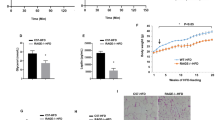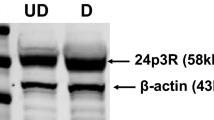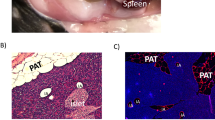Abstract
Objectives:
Autophagy is a highly regulated process that has an important role in the control of a wide range of cellular functions, such as organelle recycling, nutrient availability and tissue differentiation. A recent study has shown an increased autophagic activity in the adipose tissue of obese subjects, and a role for autophagy in obesity-associated insulin resistance was proposed. Body mass reduction is the most efficient approach to tackle insulin resistance in over-weight subjects; however, the impact of weight loss in adipose tissue autophagy is unknown.
Subjects:
Adipose tissue autophagy was evaluated in mice and humans.
Results:
First, a mouse model of diet-induced obesity and diabetes was maintained on a 15-day, 40% caloric restriction. At baseline, markers of autophagy were increased in obese mice as compared with lean controls. Upon caloric restriction, autophagy increased in the lean mice, whereas it decreased in the obese mice. The reintroduction of ad libitum feeding was sufficient to rapidly reduce autophagy in the lean mice and increase autophagy in the obese mice. In the second part of the study, autophagy was evaluated in the subcutaneous adipose tissue of nine obese-non-diabetic and six obese-diabetic subjects undergoing bariatric surgery for body mass reduction. Specimens were collected during the surgery and approximately 1 year later. Markers of systemic inflammation, such as tumor necrosis factor-1α, interleukin (IL)-6 and IL-1β were evaluated. As in the mouse model, human obesity was associated with increased autophagy, and body mass reduction led to an attenuation of autophagy in the adipose tissue.
Conclusion:
Obesity and caloric overfeeding are associated with the defective regulation of autophagy in the adipose tissue. The studies in obese-diabetic subjects undergoing improved metabolic control following calorie restriction suggest that autophagy and inflammation are regulated independently.
This is a preview of subscription content, access via your institution
Access options
Subscribe to this journal
Receive 12 print issues and online access
$259.00 per year
only $21.58 per issue
Buy this article
- Purchase on Springer Link
- Instant access to full article PDF
Prices may be subject to local taxes which are calculated during checkout







Similar content being viewed by others
References
Kahn SE, Hull RL, Utzschneider KM . Mechanisms linking obesity to insulin resistance and type 2 diabetes. Nature 2006; 444: 840–846.
Gregor MF, Hotamisligil GS . Inflammatory mechanisms in obesity. Annu Rev Immunol 2011; 29: 415–445.
Ozcan U, Cao Q, Yilmaz E, Lee AH, Iwakoshi NN, Ozdelen E et al. Endoplasmic reticulum stress links obesity, insulin action, and type 2 diabetes. Science 2004; 306: 457–461.
Hotamisligil GS . Endoplasmic reticulum stress and the inflammatory basis of metabolic disease. Cell 2010; 140: 900–917.
Cnop M, Foufelle F, Velloso LA . Endoplasmic reticulum stress, obesity and diabetes. Trends Mol Med 2012; 18: 59–68.
Hotamisligil GS . Inflammation and endoplasmic reticulum stress in obesity and diabetes. Int J Obes (Lond) 2008; 32 (Suppl 7): S52–S54.
Yang L, Li P, Fu S, Calay ES, Hotamisligil GS . Defective hepatic autophagy in obesity promotes ER stress and causes insulin resistance. Cell Metab 2010; 11: 467–478.
Kundu M, Thompson CB . Autophagy: basic principles and relevance to disease. Annu Rev Pathol 2008; 3: 427–455.
Mizushima N, Levine B, Cuervo AM, Klionsky DJ . Autophagy fights disease through cellular self-digestion. Nature 2008; 451: 1069–1075.
Mizushima N, Klionsky DJ . Protein turnover via autophagy: implications for metabolism. Annu Rev Nutr 2007; 27: 19–40.
Delgado M, Singh S, De Haro S, Master S, Ponpuak M, Dinkins C et al. Autophagy and pattern recognition receptors in innate immunity. Immunol Rev 2009; 227: 189–202.
Botti J, Djavaheri-Mergny M, Pilatte Y, Codogno P . Autophagy signaling and the cogwheels of cancer. Autophagy 2006; 2: 67–73.
Kroemer G, Marino G, Levine B . Autophagy and the integrated stress response. Mol Cell 2010; 40: 280–293.
Kovsan J, Bluher M, Tarnovscki T, Kloting N, Kirshtein B, Madar L et al. Altered autophagy in human adipose tissues in obesity. J Clin Endocrinol Metab 2011; 96: E268–E277.
Tang F, Watkins JW, Bermudez M, Gray R, Gaban A, Portie K et al. A life-span extending form of autophagy employs the vacuole-vacuole fusion machinery. Autophagy 2008; 4: 874–886.
Rubinsztein DC, Marino G, Kroemer G . Autophagy and aging. Cell 2011; 146: 682–695.
Gastrointestinal surgery for severe obesity: National Institutes of Health Consensus Development Conference Statement. Am J Clin Nutr 1992; 55 (2 Suppl): 615S–619S.
Klionsky DJ, Abdalla FC, Abeliovich H, Abraham RT, Acevedo-Arozena A, Adeli K et al. Guidelines for the use and interpretation of assays for monitoring autophagy. Autophagy 2012; 8: 445–544.
Rossmeisl M, Rim JS, Koza RA, Kozak LP . Variation in type 2 diabetes--related traits in mouse strains susceptible to diet-induced obesity. Diabetes 2003; 52: 1958–1966.
De Souza CT, Araujo EP, Stoppiglia LF, Pauli JR, Ropelle E, Rocco SA et al. Inhibition of UCP2 expression reverses diet-induced diabetes mellitus by effects on both insulin secretion and action. FASEB J 2007; 21: 1153–1163.
Ost A, Svensson K, Ruishalme I, Brannmark C, Franck N, Krook H et al. Attenuated mTOR signaling and enhanced autophagy in adipocytes from obese patients with type 2 diabetes. Mol Med 2010; 16: 235–246.
Zhang Y, Goldman S, Baerga R, Zhao Y, Komatsu M, Jin S . Adipose-specific deletion of autophagy-related gene 7 (atg7) in mice reveals a role in adipogenesis. Proc Natl Acad Sci USA 2009; 106: 19860–19865.
Goldman S, Zhang Y, Jin S . Autophagy and adipogenesis: implications in obesity and type II diabetes. Autophagy 2010; 6: 179–181.
Moscat J, Diaz-Meco MT . Feedback on fat: p62-mTORC1-autophagy connections. Cell 2011; 147: 724–727.
Codogno P, Meijer AJ . Autophagy: a potential link between obesity and insulin resistance. Cell Metab 2010; 11: 449–451.
Kopp HP, Kopp CW, Festa A, Krzyzanowska K, Kriwanek S, Minar E et al. Impact of weight loss on inflammatory proteins and their association with the insulin resistance syndrome in morbidly obese patients. Arterioscler Thromb Vasc Biol 2003; 23: 1042–1047.
Lima MM, Pareja JC, Alegre SM, Geloneze SR, Kahn SE, Astiarraga BD et al. Acute effect of roux-en-y gastric bypass on whole-body insulin sensitivity: a study with the euglycemic-hyperinsulinemic clamp. J Clin Endocrinol Metab 2010; 95: 3871–3875.
van de Sande-Lee S, Pereira FR, Cintra DE, Fernandes PT, Cardoso AR, Garlipp CR et al. Partial reversibility of hypothalamic dysfunction and changes in brain activity after body mass reduction in obese subjects. Diabetes 2011; 60: 1699–1704.
Geloneze SR, Geloneze B, Morari J, Matos-Souza JR, Lima MM, Chaim EA et al. PGC1alpha gene Gly482Ser polymorphism predicts improved metabolic, inflammatory and vascular outcomes following bariatric surgery. Int J Obes (Lond) 2012; 36: 363–368.
Gregor MF, Yang L, Fabbrini E, Mohammed BS, Eagon JC, Hotamisligil GS et al. Endoplasmic reticulum stress is reduced in tissues of obese subjects after weight loss. Diabetes 2009; 58: 693–700.
Cancello R, Tordjman J, Poitou C, Guilhem G, Bouillot JL, Hugol D et al. Increased infiltration of macrophages in omental adipose tissue is associated with marked hepatic lesions in morbid human obesity. Diabetes 2006; 55: 1554–1561.
Acknowledgements
We thank Dr ER Roman, Mr JG Ferraz and Mr M Cruz from the University of Campinas for technical assistance. We thank Dr N Conran for editing the English grammar. The support for the study was provided by Fundação de Amparo a Pesquisa do Estado de Sao Paulo and Conselho Nacional de Desenvolvimento Cientifico e Tecnologico.
Author information
Authors and Affiliations
Corresponding author
Ethics declarations
Competing interests
The authors declare no conflict of interest.
Rights and permissions
About this article
Cite this article
Nuñez, C., Rodrigues, V., Gomes, F. et al. Defective regulation of adipose tissue autophagy in obesity. Int J Obes 37, 1473–1480 (2013). https://doi.org/10.1038/ijo.2013.27
Received:
Revised:
Accepted:
Published:
Issue Date:
DOI: https://doi.org/10.1038/ijo.2013.27
Keywords
This article is cited by
-
Autophagy: a molecular switch to regulate adipogenesis and lipolysis
Molecular and Cellular Biochemistry (2022)
-
Combined training increases thermogenic fat activity in patients with overweight and type 2 diabetes
International Journal of Obesity (2022)
-
Understanding the molecular mechanisms and role of autophagy in obesity
Molecular Biology Reports (2021)
-
Autophagy in metabolic syndrome: breaking the wheel by targeting the renin–angiotensin system
Cell Death & Disease (2020)
-
A20 deubiquitinase controls PGC-1α expression in the adipose tissue
Lipids in Health and Disease (2018)



